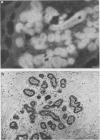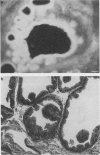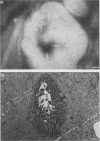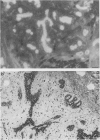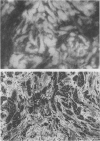Abstract
Reduced glutathione (GSH) has been demonstrated in benign and malignant human breast lesions using a newly developed histofluorescence technique. GSH was present in every lesion and in each case was localised to the epithelium. A semi-quantitative assessment revealed a moderate amount of GSH in normal epithelium and fibroadenoma and a high level in apocrine metaplasia, epitheliosis and intraduct carcinoma. Invasive ductal carcinoma contained a variable amount of GSH. Correlation between fluorescence intensity and histological grade of ductal carcinomas was almost statistically significant but a relationship to oestrogen receptor status was not detected. The rapid assessment of GSH in breast cancer may aid in the selection of optimum chemotherapeutic regimens.
Full text
PDF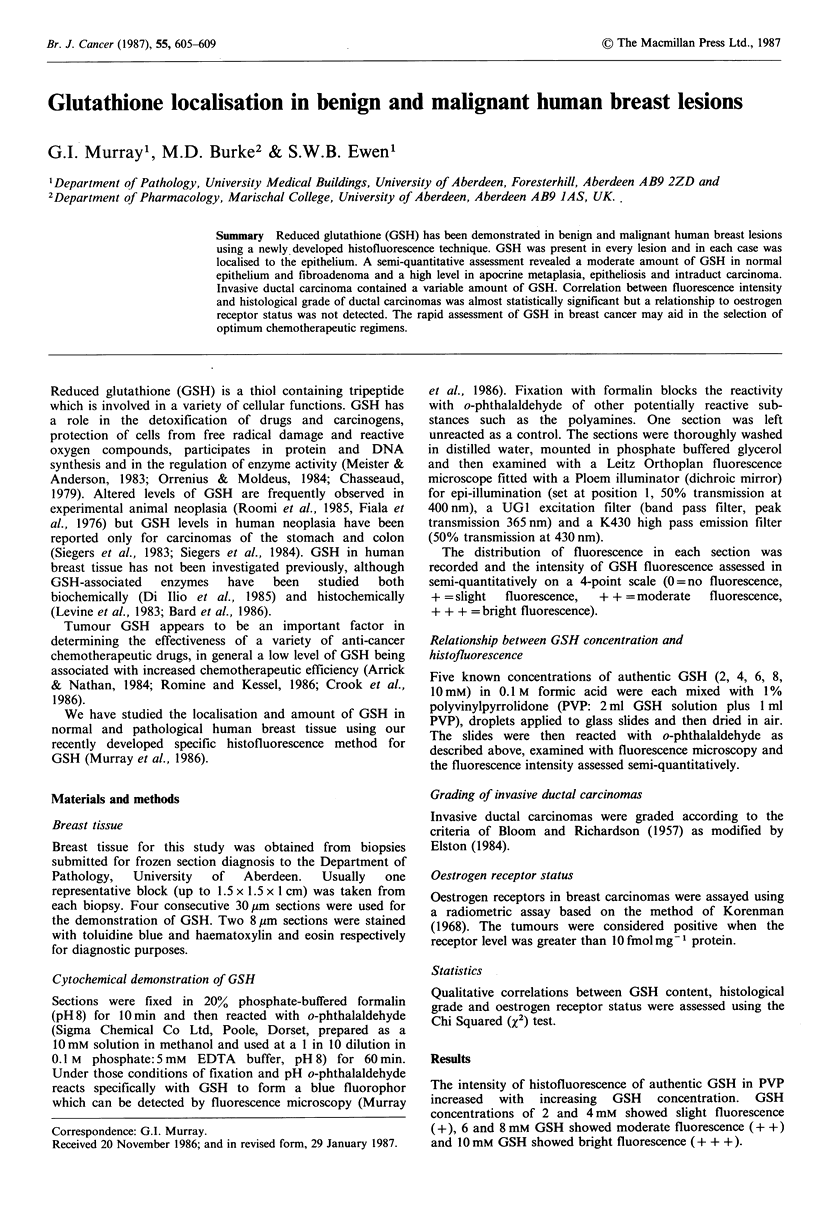
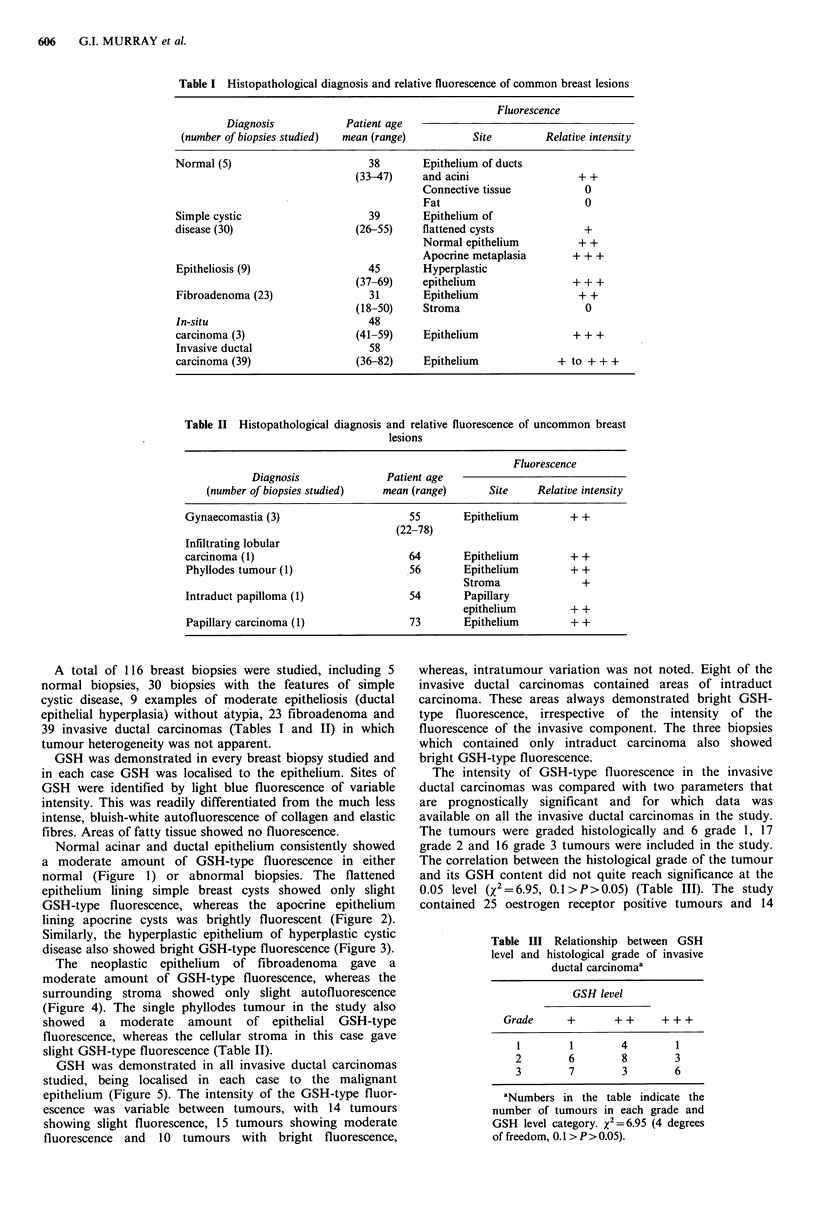
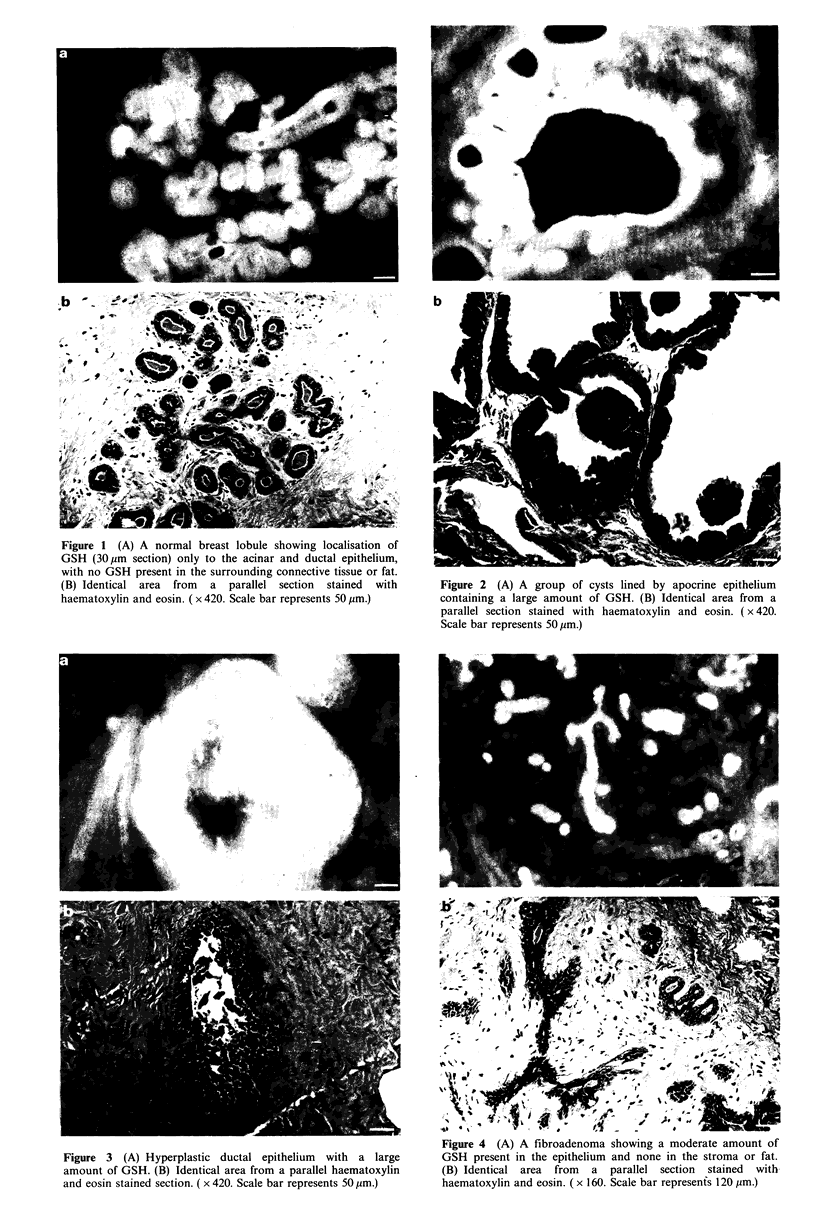
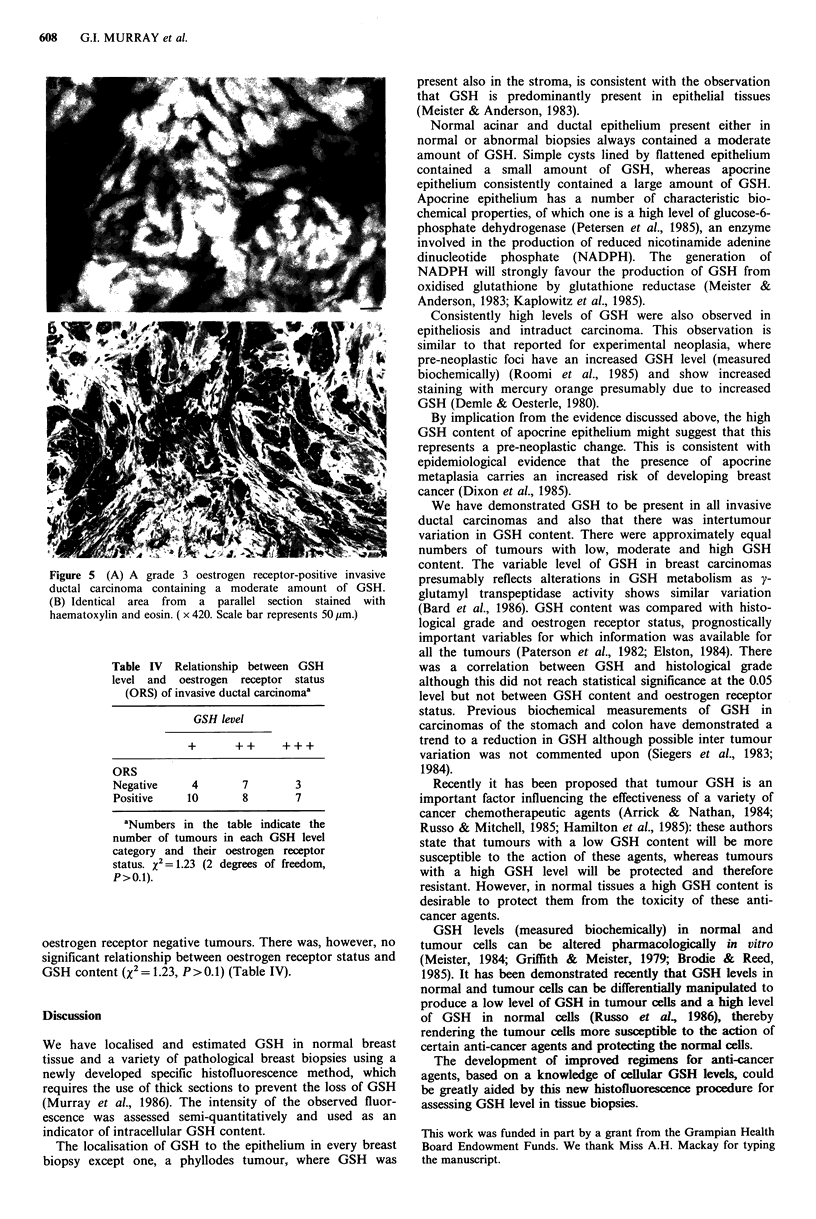
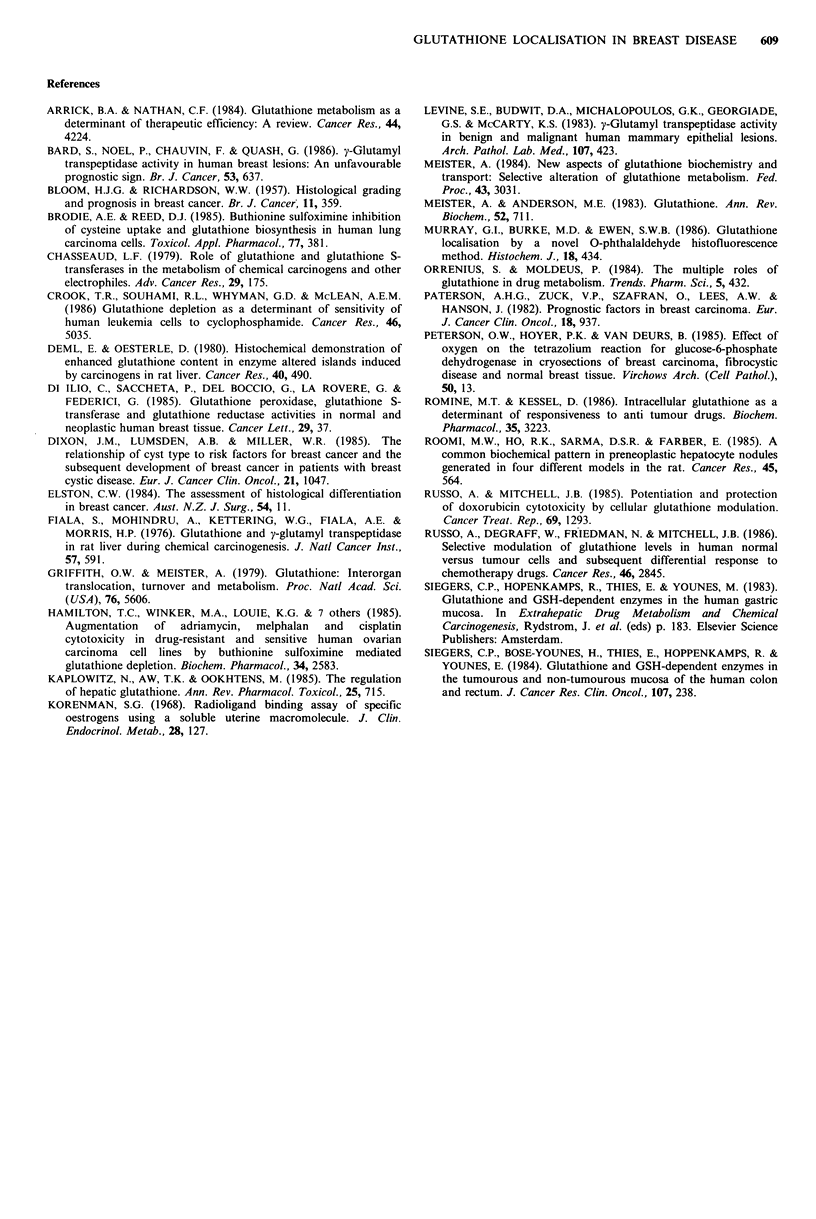
Images in this article
Selected References
These references are in PubMed. This may not be the complete list of references from this article.
- Arrick B. A., Nathan C. F. Glutathione metabolism as a determinant of therapeutic efficacy: a review. Cancer Res. 1984 Oct;44(10):4224–4232. [PubMed] [Google Scholar]
- BLOOM H. J., RICHARDSON W. W. Histological grading and prognosis in breast cancer; a study of 1409 cases of which 359 have been followed for 15 years. Br J Cancer. 1957 Sep;11(3):359–377. doi: 10.1038/bjc.1957.43. [DOI] [PMC free article] [PubMed] [Google Scholar]
- Bard S., Noël P., Chauvin F., Quash G. gamma-Glutamyltranspeptidase activity in human breast lesions: an unfavourable prognostic sign. Br J Cancer. 1986 May;53(5):637–642. doi: 10.1038/bjc.1986.107. [DOI] [PMC free article] [PubMed] [Google Scholar]
- Brodie A. E., Reed D. J. Buthionine sulfoximine inhibition of cystine uptake and glutathione biosynthesis in human lung carcinoma cells. Toxicol Appl Pharmacol. 1985 Mar 15;77(3):381–387. doi: 10.1016/0041-008x(85)90177-2. [DOI] [PubMed] [Google Scholar]
- Chasseaud L. F. The role of glutathione and glutathione S-transferases in the metabolism of chemical carcinogens and other electrophilic agents. Adv Cancer Res. 1979;29:175–274. doi: 10.1016/s0065-230x(08)60848-9. [DOI] [PubMed] [Google Scholar]
- Crook T. R., Souhami R. L., Whyman G. D., McLean A. E. Glutathione depletion as a determinant of sensitivity of human leukemia cells to cyclophosphamide. Cancer Res. 1986 Oct;46(10):5035–5038. [PubMed] [Google Scholar]
- Deml E., Oesterle D. Histochemical demonstration of enhanced glutathione content in enzyme-altered islands induced by carcinogens in rat liver. Cancer Res. 1980 Feb;40(2):490–491. [PubMed] [Google Scholar]
- Dixon J. M., Lumsden A. B., Miller W. R. The relationship of cyst type to risk factors for breast cancer and the subsequent development of breast cancer in patients with breast cystic disease. Eur J Cancer Clin Oncol. 1985 Sep;21(9):1047–1050. doi: 10.1016/0277-5379(85)90289-5. [DOI] [PubMed] [Google Scholar]
- Elston C. W. The assessment of histological differentiation in breast cancer. Aust N Z J Surg. 1984 Feb;54(1):11–15. doi: 10.1111/j.1445-2197.1984.tb06677.x. [DOI] [PubMed] [Google Scholar]
- Fiala S., Mohindru A., Kettering W. G., Fiala A. E., Morris H. P. Glutathione and gamma glutamyl transpeptidase in rat liver during chemical carcinogenesis. J Natl Cancer Inst. 1976 Sep;57(3):591–598. doi: 10.1093/jnci/57.3.591. [DOI] [PubMed] [Google Scholar]
- Griffith O. W., Meister A. Glutathione: interorgan translocation, turnover, and metabolism. Proc Natl Acad Sci U S A. 1979 Nov;76(11):5606–5610. doi: 10.1073/pnas.76.11.5606. [DOI] [PMC free article] [PubMed] [Google Scholar]
- Hamilton T. C., Winker M. A., Louie K. G., Batist G., Behrens B. C., Tsuruo T., Grotzinger K. R., McKoy W. M., Young R. C., Ozols R. F. Augmentation of adriamycin, melphalan, and cisplatin cytotoxicity in drug-resistant and -sensitive human ovarian carcinoma cell lines by buthionine sulfoximine mediated glutathione depletion. Biochem Pharmacol. 1985 Jul 15;34(14):2583–2586. doi: 10.1016/0006-2952(85)90551-9. [DOI] [PubMed] [Google Scholar]
- Kaplowitz N., Aw T. Y., Ookhtens M. The regulation of hepatic glutathione. Annu Rev Pharmacol Toxicol. 1985;25:715–744. doi: 10.1146/annurev.pa.25.040185.003435. [DOI] [PubMed] [Google Scholar]
- Korenman S. G. Radio-ligand binding assay of specific estrogens using a soluble uterine macromolecule. J Clin Endocrinol Metab. 1968 Jan;28(1):127–130. doi: 10.1210/jcem-28-1-127. [DOI] [PubMed] [Google Scholar]
- Levine S. E., Budwit D. A., Michalopoulos G. K., Georgiade G. S., McCarty K. S., Jr gamma-Glutamyl transpeptidase activity in benign and malignant human mammary epithelial lesions. Histochemical evaluation. Arch Pathol Lab Med. 1983 Aug;107(8):423–427. [PubMed] [Google Scholar]
- Meister A., Anderson M. E. Glutathione. Annu Rev Biochem. 1983;52:711–760. doi: 10.1146/annurev.bi.52.070183.003431. [DOI] [PubMed] [Google Scholar]
- Meister A. New aspects of glutathione biochemistry and transport: selective alteration of glutathione metabolism. Fed Proc. 1984 Dec;43(15):3031–3042. [PubMed] [Google Scholar]
- Murray G. I., Burke M. D., Ewen S. W. Glutathione localization by a novel o-phthalaldehyde histofluorescence method. Histochem J. 1986 Aug;18(8):434–440. doi: 10.1007/BF01675336. [DOI] [PubMed] [Google Scholar]
- Paterson A. H., Zuck V. P., Szafran O., Lees A. W., Hanson J. Influence and significance of certain prognostic factors on survival in breast cancer. Eur J Cancer Clin Oncol. 1982 Oct;18(10):937–943. doi: 10.1016/0277-5379(82)90241-3. [DOI] [PubMed] [Google Scholar]
- Roomi M. W., Ho R. K., Sarma D. S., Farber E. A common biochemical pattern in preneoplastic hepatocyte nodules generated in four different models in the rat. Cancer Res. 1985 Feb;45(2):564–571. [PubMed] [Google Scholar]
- Russo A., DeGraff W., Friedman N., Mitchell J. B. Selective modulation of glutathione levels in human normal versus tumor cells and subsequent differential response to chemotherapy drugs. Cancer Res. 1986 Jun;46(6):2845–2848. [PubMed] [Google Scholar]
- Russo A., Mitchell J. B. Potentiation and protection of doxorubicin cytotoxicity by cellular glutathione modulation. Cancer Treat Rep. 1985 Nov;69(11):1293–1296. [PubMed] [Google Scholar]
- Siegers C. P., Böse-Younes H., Thies E., Hoppenkamps R., Younes M. Glutathione and GSH-dependent enzymes in the tumorous and nontumorous mucosa of the human colon and rectum. J Cancer Res Clin Oncol. 1984;107(3):238–241. doi: 10.1007/BF01032615. [DOI] [PubMed] [Google Scholar]
- di Ilio C., Sacchetta P., del Boccio G., la Rovere G., Federici G. Glutathione peroxidase, glutathione S-transferase and glutathione reductase activities in normal and neoplastic human breast tissue. Cancer Lett. 1985 Oct;29(1):37–42. doi: 10.1016/0304-3835(85)90120-x. [DOI] [PubMed] [Google Scholar]



